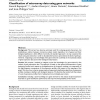61 search results - page 10 / 13 » The use of animation to explain genetic algorithms |
MM
2006
ACM
14 years 1 months ago
2006
ACM
While there have been great advances in quantification of the genotype of organisms, including full genomes for many species, the quantification of phenotype is at a comparatively...
ICALT
2007
IEEE
14 years 1 months ago
2007
IEEE
A design of e-Learning environment is described for personalized adaptability. At first, we explain the whole system of our learning management system, WebClass RAPSODY, which has...
BMCBI
2007
13 years 7 months ago
2007
Background: Microarrays have become extremely useful for analysing genetic phenomena, but establishing a relation between microarray analysis results (typically a list of genes) a...
GECCO
2008
Springer
13 years 8 months ago
2008
Springer
This paper discusses interactive evolutionary algorithms and their application in swarm-based image generation. From an artist’s perspective, the computer-generated patterns oï¬...
CVPR
2010
IEEE
13 years 6 months ago
2010
IEEE
We present a hierarchical principle for object recognition and its application to automatically classify developmental stages of C. elegans animals from a population of mixed stag...

